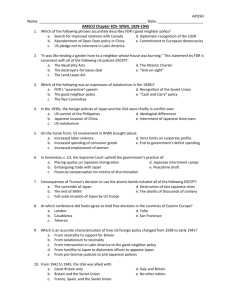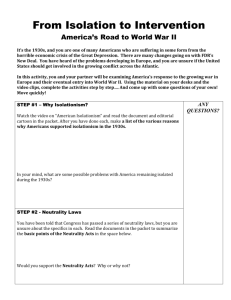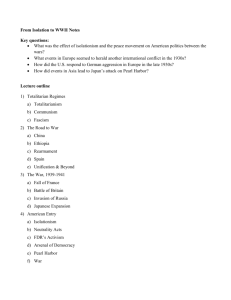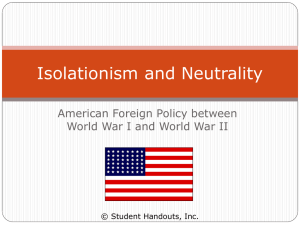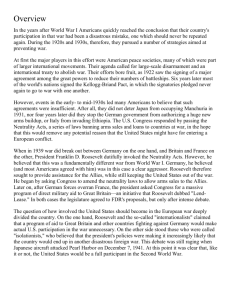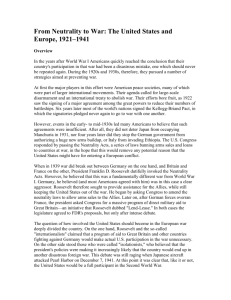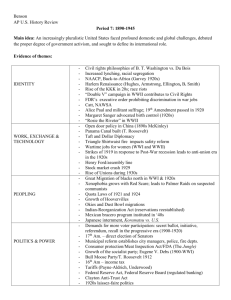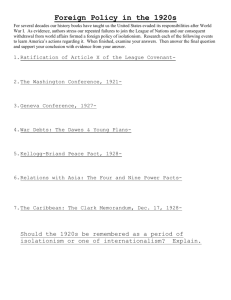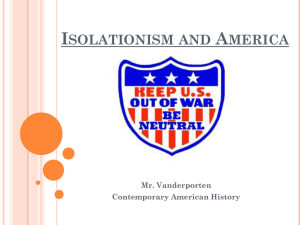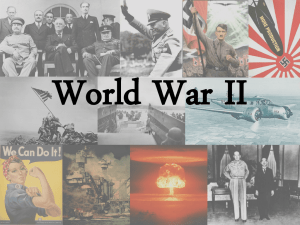From Isolation to Intervention
advertisement
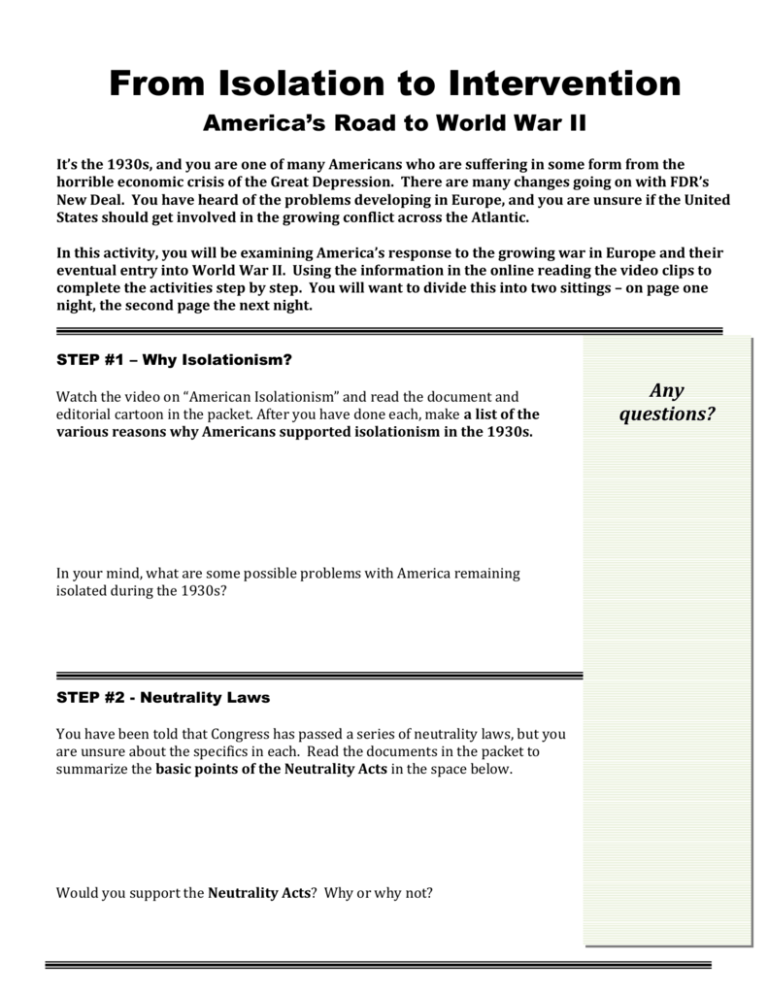
From Isolation to Intervention America’s Road to World War II It’s the 1930s, and you are one of many Americans who are suffering in some form from the horrible economic crisis of the Great Depression. There are many changes going on with FDR’s New Deal. You have heard of the problems developing in Europe, and you are unsure if the United States should get involved in the growing conflict across the Atlantic. In this activity, you will be examining America’s response to the growing war in Europe and their eventual entry into World War II. Using the information in the online reading the video clips to complete the activities step by step. You will want to divide this into two sittings – on page one night, the second page the next night. STEP #1 – Why Isolationism? Watch the video on “American Isolationism” and read the document and editorial cartoon in the packet. After you have done each, make a list of the various reasons why Americans supported isolationism in the 1930s. In your mind, what are some possible problems with America remaining isolated during the 1930s? STEP #2 - Neutrality Laws You have been told that Congress has passed a series of neutrality laws, but you are unsure about the specifics in each. Read the documents in the packet to summarize the basic points of the Neutrality Acts in the space below. Would you support the Neutrality Acts? Why or why not? Any questions? STEP #3 – Building America’s Defense You have heard that, even though the United States is not joining either side of the war and has chosen to remain neutral, the country has agreed to build up the country’s military. Why are they doing so? In what ways are they strengthening their armed forces? What do you think this may do to the economy? STEP #4 – Cash and Carry You have heard rumblings in the news about Congress possibly changing its neutral ways and trading with nations at war by passing the “Cash and Carry” Plan. What is the “Cash and Carry” Plan? What are the arguments for and against the plan? Would you support the plan? Why or why not? STEP #5 – The America First Committee What was the AFC, and what were their arguments against involvement in the War in Europe? Any questions? Why did some American oppose the AFC? Would you have supported the AFC? Why or Why not? STEP #6 – The 1940 Election It is 1940 – an election year! What is the result of the election of 1940, and why? What is your reaction to this result? Do you think the nation made the right choice? Why or why not? STEP #7 – The Arsenal of Democracy Not long after his re-election, President Roosevelt held another of his fireside chats on the radio. There was no hope of negotiating a peace with Hitler. He told you and the nation, "No man can tame a tiger into a kitten by strangling it." He also warned that if Britain fell, the Axis powers would be left unchallenged to conquer the world, at which point, he said, "all of us in all the Americas would be living at the point of a gun," To prevent such a situation, the United States had to help defeat the Axis threat by turning itself into "the great arsenal of democracy." What do you think he means by this? What is this “Lend Lease” Act that Congress has now passed, under the pushing of FDR? Any questions? Will this act lead the US closer to war? What do you think? Any questions? STEP #8 – The Atlantic Charter You have found out that FDR and the new Prime Minister of Great Britain, Winston Churchill, have met in Newfoundland to discuss the future relationship between the two countries. While they haven’t made any alliance, they have agreed on something called “The Atlantic Charter”. What is it? In the charter, each nation agreed to (1) seek no _____________________ expansion (2) pursue no territorial changes without the consent of the _____________________ (3) respect the right of people to choose their own form of_____________________ (4) promote _____________________among nations (5) encourage international _____________________ to improve peoples' lives (6) build a secure peace based on freedom from want and fear (7) work for _____________________ of aggressors (8) establish a "permanent system of general _____________________" What do you think this Atlantic Charter will do for the relationship between the US (FDR) and England (Churchill)? STEP #9 – Trouble with Japan The US has been focusing on helping the British and French in Europe, but there are problems with the Japanese. What is going on with them? What did the Japanese do in response to American actions? America Enters the War: World War II (Overview) British Policy: Appeasement In the 1930s, both Germany and Italy adopted fascism and began moves to expand their territory. Japan's totalitarian government was also looking to expand. Great Britain's prime minister Neville Chamberlain urged Britain to maintain a policy of appeasement—giving in to the dictators in order to avoid a war. In part, Chamberlain had to try appeasement because the British Empire did not have the resources to fight Japan in Asia, Italy in the Mediterranean, and Germany in Europe all at the same time. Unfortunately, the policy failed because the dictators believed that Britain was weak and inferior and therefore no threat to their desires for land. When Britain became aware that Germany's air force was rapidly overtaking their own, they looked to the United States for help. American Policy: Isolationism Following World War I, the United States had once again retreated into isolationism. The U.S. government believed that its interests were best served by secluding itself from other nations and avoiding alliances with them. The United States had a history of isolationism dating back to the presidential terms of George Washington; he had urged commercial treaties and expansion of trade with other nations but no political or military alliances. In 1823, in keeping with that practice and at the urging of President James Monroe, Congress adopted the Monroe Doctrine, which called on the United States to stay out of European affairs and warned Europeans to stay out of American affairs. More legislation was passed in the 1930s to ensure the United States' stance of isolationism. The Johnson Act of 1934 prohibited loans to foreign countries that had not paid their war debts. The Neutrality Acts of 1935 and 1936 prohibited the sale of war materials to aggressors. President Franklin D. Roosevelt issued his Good Neighbor Policy in his first inaugural address. The policy promoted condemnation of aggression, no forcible collection of debts, equality of states, respect for treaties, and continental solidarity. Lend-Lease Act However, as Italy, Germany, and Japan became more aggressive and formed the Rome-BerlinTokyo Axis pledging to support each other, the United States could no longer ignore the situation. In March 1941, Congress passed the Lend-Lease Act, which initially appropriated $7 billion to be used to loan or lease weapons and to provide aid to other countries. Much of that money was invested to help Britain secure the seas in order to ensure the delivery of badly needed resources and supplies to the island. The United States still hoped to ensure a victory over the Axis powers without involving its own troops. Japanese Aggression Meanwhile, Japanese aggression was spreading. In September 1940, Japan occupied northern Indochina. Bound by the Neutrality Acts, the United States responded by prohibiting the export of steel, scrap iron, and aviation gasoline to Japan. Roosevelt also approved a loan of $100 million to the Nationalist Chinese under the provisions of the Lend-Lease Act to combat Japanese aggression. Not quite a year later, in July 1941, Japan occupied southern Indochina. This time, Britain and the Netherlands joined the United States' protest by freezing Japanese assets. That meant that Japan was prevented from purchasing the oil needed to fuel its army, navy, and air force. Still, Japan was determined to carve out a new empire. Attack on Pearl Harbor On December 1, 1941, Japan's premier Tojo Hideki concluded, "Japan has no other way than to wage war . . . to secure its existence and self-defense." On Sunday, December 7, news of Japan's attack on U.S. forces at Pearl Harbor, Hawaii reached Washington, D.C. The next day, Roosevelt declared that it was "a day which will live in infamy" and asked Congress for a declaration of war on Japan. On December 11, Germany's Adolf Hitler and Italy's Benito Mussolini honored their pact with Japan and declared war on the United States. The United States had entered the war in both Asia and Europe. "America Enters the War: World War II (Overview)." American History. 2008. ABC-CLIO. 14 Apr. 2008 http://www.americanhistory.abc-clio.com>.
